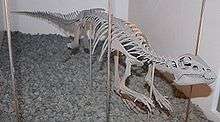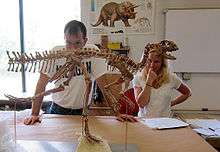Hypsilophodont
| Hypsilophodonts Temporal range: Early Cretaceous, 130–125 Ma | |
|---|---|
 | |
| Hypsilophodon | |
| Scientific classification | |
| Kingdom: | Animalia |
| Phylum: | Chordata |
| Class: | Reptilia |
| Clade: | Dinosauria |
| Order: | †Ornithischia |
| Suborder: | †Ornithopoda |
| Clade: | †Hypsilophodontia |
| Family: | †Hypsilophodontidae Dollo, 1882 |
| Genera | |
Hypsilophodonts (named after Hypsilophodon, itself derived from the Hypsilophus ("high-crested") genus of iguana lizard and literally meaning "Hypsilophus-tooth") were small ornithopod dinosaurs, regarded as fast, herbivorous bipeds on the order of 1–2 meters long (3.3–6.6 feet). They are known from Asia, Australia, Europe, New Zealand, North America, and South America, from rocks of Middle Jurassic to late Cretaceous age. The group traditionally has included almost all bipedal bird-hipped dinosaurs other than iguanodonts, and some early phylogenetic analyses found it to be a natural group,[1][2] but more recent studies have found that the group is mostly paraphyletic and the taxa within represent a series leading up to Iguanodontia.[3][4][5][6][7][8][9] Some of these studies have moved some traditional hypsilophodonts out of the Ornithopoda, such as Agilisaurus and Othnielosaurus (=Othnielia).[8][10][11] Thus, the only certain member at this time is Hypsilophodon.
Relationships
The following cladogram of hypsilophodont relationships depicts the paraphyletic hypotheses; the "natural Hypsilophodontidae" hypothesis has been falling out of favor since the mid-late 1990s. It is after Brown et al. (2013), the most recent analysis of hypsilophodonts.[12] Ornithischia, Ornithopoda, and Iguanodontia were not designated in their result, and so are left out here. Additional ornithopods beyond Tenontosaurus are omitted. Dinosaurs traditionally described as hypsilophodonts are found from Agilisaurus or Hexinlusaurus to Hypsilophodon or Gasparinisaura.
| unnamed |
| |||||||||||||||||||||||||||||||||||||||||||||||||||||||||||||||||||||||||||||||||||||||||||||||||||||||||||||||
| |

In the most recent review of hypsilophodonts, by Norman et al. (2004),[7] the following genera were known well enough to include in a phylogenetic analysis:
- Agilisaurus
- A. multidens (now Hexinlusaurus)[13]
- Bugenasaura (now regarded as a junior synonym of Thescelosaurus)[9]
- Gasparinisaura
- Hypsilophodon
- Orodromeus
- Othnielia (now Othnielosaurus)[14]
- Koreanosaurus[15]
- Parksosaurus
- Thescelosaurus
- Zephyrosaurus
The following genera were regarded as valid, but were not classified:[7]
- Anabisetia
- Atlascopcosaurus
- Drinker
- "Gongbusaurus" wucaiwanensis (= "Eugongbusaurus")
- Fulgurotherium
- Jeholosaurus
- Leaellynasaura
- Notohypsilophodon
- Qantassaurus
- Yandusaurus
- "Proctor Lake hypsilophodont"
Several other genera belong here somewhere, but are very poorly known or outright dubious:[7]
Paleobiology
Hypsilophodonts were small (often 1–2 m [3.28 to 6.56 ft (2.00 m)] long), bipedal, cursorial herbivores.[7] The typical informal comparison has been to gazelles. However, there is evidence that at least some of them made burrows as places to rear their young.[8] While so far only known for Oryctodromeus, additional possible hypsilophodont burrows have been found in slightly older rocks in Victoria, Australia.[16]
References
- ↑ Sues, Hans-Dieter; Norman, David B. (1990). "Hypsilophodontidae, Tenontosaurus, Dryosauridae". In Weishampel, David B.; Dodson, Peter; Osmólska Halszka (eds.). The Dinosauria (1st ed.). Berkeley: University of California Press. pp. 498–509. ISBN 0-520-06727-4.
- ↑ Weishampel, David B.; Heinrich, Ronald E. (1992). "Systematics of Hypsilophodontidae and Basal Iguanodontia (Dinosauria: Ornithopoda)" (PDF). Historical Biology. 6 (3): 159–184. doi:10.1080/10292389209380426. Retrieved 2007-03-10.
- ↑ Scheetz, Rodney D. (1998). "Phylogeny of basal ornithopod dinosaurs and the dissolution of the Hypsilophodontidae". Journal of Vertebrate Paleontology. 18 (3, Suppl.): 75A. doi:10.1080/02724634.1998.10011116.
- ↑ Winkler, Dale A.; Murry, Phillip A.; Jacobs, Louis L. (1998). "The new ornithopod dinosaur from Proctor Lake, Texas, and the deconstruction of the family Hypsilophodontidae". Journal of Vertebrate Paleontology. 18 (3, Suppl.): 87A. doi:10.1080/02724634.1998.10011116.
- ↑ Buchholz, Peter W. (2002). "Phylogeny and biogeography of basal Ornithischia". The Mesozoic in Wyoming, Tate 2002. Casper, Wyoming: The Geological Museum, Casper College. pp. 18–34.
- ↑ Weishampel, David B.; Jianu, Coralia-Maria; Csiki, Z.; Norman, David B. (2003). "Osteology and phylogeny of Zalmoxes (n.g.), an unusual euornithopod dinosaur from the latest Cretaceous of Romania". Journal of Systematic Palaeontology. 1 (2): 1–56. doi:10.1017/S1477201903001032.
- 1 2 3 4 5 Norman, David B.; Sues, Hans-Dieter; Witmer, Larry M.; Coria, Rodolfo A. (2004). "Basal Ornithopoda". In Weishampel, David B.; Dodson, Peter; Osmólska Halszka (eds.). The Dinosauria (2nd ed.). Berkeley: University of California Press. pp. 393–412. ISBN 0-520-24209-2.
- 1 2 3 Varricchio, David J.; Martin, Anthony J.; Katsura, Yoshihiro (2007). "First trace and body fossil evidence of a burrowing, denning dinosaur" (PDF). Proceedings of the Royal Society B: Biological Sciences. 274 (1616): 1361–1368. doi:10.1098/rspb.2006.0443. PMC 2176205
 . PMID 17374596. Retrieved 2007-03-22.
. PMID 17374596. Retrieved 2007-03-22. - 1 2 Boyd, Clint A.; Brown, Caleb M.; Scheetz, Rodney D.; Clarke, Julia A. (2009). "Taxonomic revision of the basal neornithischian taxa Thescelosaurus and Bugenasaura". Journal of Vertebrate Paleontology. 29 (3): 758–770. doi:10.1671/039.029.0328.
- ↑ Butler, Richard J.; Smith, Roger M.H.; Norman, David B. (2007). "A primitive ornithischian dinosaur from the Late Triassic of South Africa, and the early evolution and diversification of Ornithischia". Proceedings of the Royal Society B: Biological Sciences. 274 (1621): 2041–6. doi:10.1098/rspb.2007.0367. PMC 2275175
 . PMID 17567562.
. PMID 17567562. - ↑ Butler, Richard J.; Upchurch, Paul; Norman, David B. (2008). "The phylogeny of the ornithischian dinosaurs". Journal of Systematic Palaeontology. 6 (1): 1–40. doi:10.1017/S1477201907002271.
- ↑ Brown, C. M.; Evans, D. C.; Ryan, M. J.; Russell, A. P. (2013). "New data on the diversity and abundance of small-bodied ornithopods (Dinosauria, Ornithischia) from the Belly River Group (Campanian) of Alberta". Journal of Vertebrate Paleontology. 33 (3): 495–520. doi:10.1080/02724634.2013.746229.
- ↑ Barrett, P.M.; Butler, R. J.; Knoll, F. (2005). "Small-bodied ornithischian dinosaurs from the Middle Jurassic of Sichuan, China". Journal of Vertebrate Paleontology. 25: 823–834. doi:10.1671/0272-4634(2005)025[0823:sodftm]2.0.co;2.
- ↑ Galton, Peter M. (2007). "Teeth of ornithischian dinosaurs (mostly Ornithopoda) from the Morrison Formation (Upper Jurassic) of the western United States". In Carpenter Kenneth (ed.). Horns and Beaks: Ceratopsian and Ornithopod Dinosaurs. Bloomington and Indianapolis: Indiana University Press. pp. 17–47. ISBN 0-253-34817-X.
- ↑ Min Huh, Dae-Gil Lee, Jung-Kyun Kim, Jong-Deock Lim, Pascal Godefroit (2011). "A new basal ornithopod dinosaur from the Upper Cretaceous of South Korea". Neues Jahrbuch für Geologie und Palaeontologie, Abhandlungen. 259 (1): 1–24. doi:10.1127/0077-7749/2010/0102.
- ↑ Martin, A.J. (2009). "Dinosaur burrows in the Otway Group (Albian) of Victoria, Australia, and their relation to Cretaceous polar environments". Cretaceous Research. 30 (5): 1223–1237. doi:10.1016/j.cretres.2009.06.003.